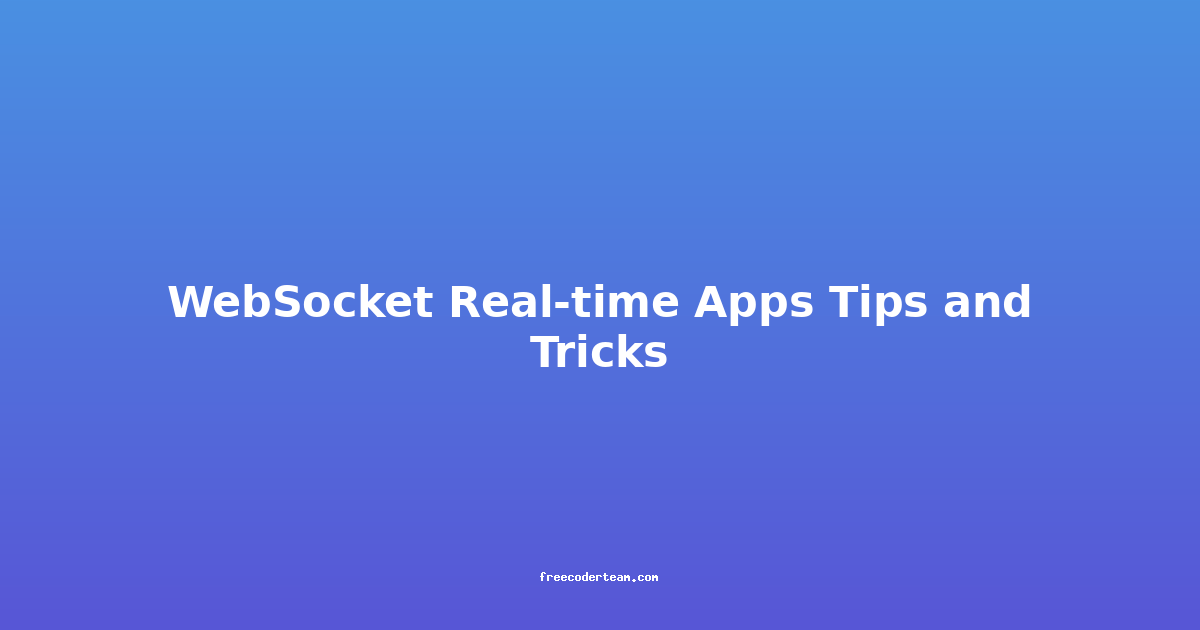WebSocket Real-Time Apps: Tips, Tricks, and Best Practices
Real-time applications have become integral to modern web development, enabling seamless communication between users and servers without the need for constant page refreshes. WebSocket technology is a cornerstone of these applications, providing a persistent, bidirectional communication channel between clients and servers. In this blog post, we'll explore practical tips, tricks, and best practices for building robust WebSocket-based real-time applications. Whether you're a beginner or an experienced developer, these insights will help you optimize your applications for performance, scalability, and reliability.
Table of Contents
- Understanding WebSocket
- Key Features of WebSocket
- Tips and Tricks for WebSocket Real-Time Apps
- Practical Example: Building a Real-Time Chat Application
- Conclusion
Understanding WebSocket
WebSocket is a protocol that enables full-duplex communication over a single TCP connection. Unlike traditional HTTP, which is request-response based, WebSocket allows both the client and server to send data at any time, making it ideal for real-time applications. It opens a long-lived connection, allowing for instant updates and minimal latency.
WebSocket operates on two main protocols:
- HTTP Upgrade: The initial connection is established via HTTP, and the client and server negotiate an upgrade to the WebSocket protocol.
- WebSocket: Once the connection is upgraded, it uses the
ws://(non-secure) orwss://(secure) protocol for communication.
Key Features of WebSocket
- Persistent Connection: Unlike HTTP, WebSocket maintains a single, long-lived connection, reducing overhead.
- Bidirectional Communication: Both the client and server can send and receive data simultaneously.
- Low Latency: WebSocket reduces latency by eliminating the need for repeated handshakes and HTTP overhead.
- Compatibility: Supported by modern browsers and many server-side frameworks.
Tips and Tricks for WebSocket Real-Time Apps
1. Use WebSocket for Real-Time Scenarios
WebSocket is designed for real-time communication. Use it for scenarios where immediate data updates are critical, such as chat applications, live dashboards, multiplayer games, and collaboration tools. Avoid using it for non-real-time scenarios where standard HTTP might suffice, as it could add unnecessary complexity.
2. Implement Secure Connections (WSS)
Always use WSS (WebSocket Secure) instead of plain WebSocket (ws://). WSS encrypts the data using TLS, ensuring secure communication between the client and server. This is especially important for applications handling sensitive data.
Example:
// Client-side implementation
const socket = new WebSocket('wss://example.com/socket');
// Server-side implementation (Node.js with Socket.IO)
const io = require('socket.io')(server, {
cors: {
origin: '*',
},
transports: ['websocket'],
});
3. Handle Connection States Effectively
WebSocket connections can go through various states: CONNECTING, OPEN, CLOSING, and CLOSED. Ensure your application handles these states gracefully to avoid errors or data loss.
Example:
const socket = new WebSocket('wss://example.com/socket');
socket.onopen = () => {
console.log('WebSocket connection opened');
// Send initial data or join a room
};
socket.onmessage = (event) => {
console.log('Received message:', event.data);
};
socket.onclose = (event) => {
console.log('WebSocket connection closed', event.code, event.reason);
// Handle reconnection logic if needed
};
socket.onerror = (error) => {
console.error('WebSocket error:', error);
};
4. Manage Message Size and Frequency
WebSocket messages should be kept small to reduce bandwidth usage and improve performance. Avoid sending large payloads in a single message. Instead, break them into smaller chunks. Additionally, manage the frequency of messages to avoid overwhelming the server or client.
Example:
// Sending small messages
socket.send(JSON.stringify({ type: 'message', content: 'Hello' }));
// Sending large data in chunks
const largeData = new ArrayBuffer(1024 * 1024);
for (let i = 0; i < largeData.byteLength; i += 1024) {
socket.send(largeData.slice(i, i + 1024));
}
5. Use Heartbeats for Connection Monitoring
Heartbeats are periodic messages sent between the client and server to ensure the connection is active. If heartbeats are missed, it indicates a potential disconnection. Implement heartbeat logic to detect and handle connection issues proactively.
Example:
// Client-side heartbeat
setInterval(() => {
socket.send(JSON.stringify({ type: 'heartbeat' }));
}, 30000);
// Server-side heartbeat listener
io.on('connection', (socket) => {
socket.on('heartbeat', () => {
console.log('Received heartbeat from client');
});
});
6. Implement Message Compression
Large messages can slow down WebSocket communication. Use compression techniques like gzip or deflate to reduce the size of messages. Most WebSocket libraries support built-in compression.
Example:
// Enable compression in Socket.IO
const io = require('socket.io')(server, {
transports: ['websocket'],
upgrades: false,
compress: true,
});
7. Scale WebSocket Servers
As your application grows, handle increased traffic by scaling your WebSocket server. Use load balancers to distribute connections across multiple servers. Additionally, consider using clustering or sharding to manage large-scale real-time applications.
Example:
- Using Node.js Clustering:
const cluster = require('cluster'); const os = require('os'); if (cluster.isMaster) { const cpuCount = os.cpus().length; for (let i = 0; i < cpuCount; i++) { cluster.fork(); } } else { const http = require('http'); const server = http.createServer(); const io = require('socket.io')(server); server.listen(3000); }
8. Use WebSocket Middleware
WebSocket middleware can help manage authentication, logging, and other application-specific logic. Use middleware to enhance the functionality and security of your WebSocket server.
Example:
io.use((socket, next) => {
const token = socket.handshake.query.token;
if (!token) {
return next(new Error('Authentication error'));
}
// Validate token and proceed
next();
});
Practical Example: Building a Real-Time Chat Application
Let's build a simple real-time chat application using WebSocket. This example uses Socket.IO, a popular library for real-time communication.
Server-side Setup
-
Install Dependencies:
npm install express socket.io -
Create the Server:
const express = require('express'); const http = require('http'); const socketIo = require('socket.io'); const app = express(); const server = http.createServer(app); const io = socketIo(server); // Middleware for logging io.use((socket, next) => { console.log(`New connection: ${socket.id}`); next(); }); // Handle WebSocket connections io.on('connection', (socket) => { console.log('Client connected:', socket.id); // Handle incoming chat messages socket.on('chat message', (data) => { console.log('Received message:', data); // Broadcast the message to all connected clients io.emit('chat message', data); }); // Handle disconnections socket.on('disconnect', () => { console.log('Client disconnected:', socket.id); }); }); // Start the server server.listen(3000, () => { console.log('Server is running on port 3000'); });
Client-side Setup
-
HTML Structure:
<!DOCTYPE html> <html lang="en"> <head> <meta charset="UTF-8"> <meta name="viewport" content="width=device-width, initial-scale=1.0"> <title>Real-Time Chat</title> </head> <body> <h1>Real-Time Chat</h1> <ul id="messages"></ul> <form id="form"> <input id="input" autocomplete="off" /> <button>Send</button> </form> <script src="/socket.io/socket.io.js"></script> <script src="client.js"></script> </body> </html> -
Client-side JavaScript:
const socket = io('http://localhost:3000'); // Handle form submission const form = document.getElementById('form'); const input = document.getElementById('input'); const messages = document.getElementById('messages'); form.addEventListener('submit', (e) => { e.preventDefault(); if (input.value) { socket.emit('chat message', { user: 'You', message: input.value }); input.value = ''; } }); // Handle incoming messages socket.on('chat message', (data) => { const li = document.createElement('li'); li.innerHTML = `${data.user}: ${data.message}`; messages.appendChild(li); });
Running the Application
-
Start the server:
node server.js -
Open the client HTML file in a browser to see the real-time chat in action.
Conclusion
WebSocket is a powerful tool for building real-time applications, offering low-latency, bidirectional communication. By following best practices such as using secure connections, managing connection states, and optimizing message size, you can build robust and scalable real-time applications. Whether you're building a chat app, a live dashboard, or a multiplayer game, WebSocket provides the foundation for seamless real-time interactions.
Remember, the key to successful WebSocket applications lies in understanding its strengths and limitations, implementing effective error handling, and ensuring scalability as your application grows. With the right approach and tools, you can deliver real-time experiences that keep users engaged and satisfied.
Happy coding! 🚀
If you have any questions or need further clarification, feel free to reach out!




